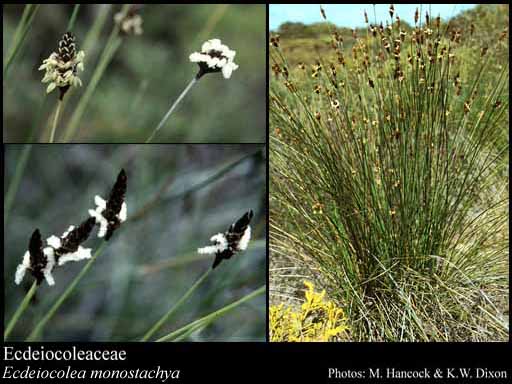- Reference
- Kew Bull. 19:195 (1965)
- Name Status
- Current







Scientific Description
Family Sometimes included in Restionaceae.
Habit and leaf form. Herbs. Switch-plants. Leaves much reduced. Perennial; plants with neither basal nor terminal concentrations of leaves. Young stems cylindrical (grooved, wiry). Rhizomatous. Xerophytic. Leaves alternate; distichous; membranous (reduced to scales); sessile; sheathing. Leaf sheaths with free margins. Leaves simple; epulvinate. Leaf blades entire; parallel-veined; without cross-venules. Leaves eligulate. Vegetative anatomy. Plants with silica bodies (as silica sand, in the culm mesophyll). Leaf anatomy. Leaf blade epidermis without differentiation into ‘long’ and ‘short’ cells. Guard-cells ‘grass type’. Stem anatomy. Secondary thickening absent.
Reproductive type, pollination. Fertile flowers functionally male and functionally female. Unisexual flowers present. Plants monoecious (male and female flowers in the one spikelet). The unisexual flowers not conspicuously in separate aggregates. Female flowers with staminodes (three staminodes). Male flowers with pistillodes. Floral nectaries absent (nectaries absent). Anemophilous.
Inflorescence and flower features. Flowers aggregated in ‘inflorescences’; in spikes; in effect, in ‘spikelets’. The terminal inflorescence unit racemose. Inflorescences terminal; small, solitary or several, terminal spikes — constituting spikelets; espatheate (i.e. no basal sheathing bract, by contrast with Restionaceae). Flowers bracteate (with basal ‘glumes’); ebracteolate; minute; 3 merous; cyclic. Perigone tube absent. Hypogynous disk absent. Perianth of ‘tepals’; 6; 2 -whorled (3+3); isomerous; free (somewhat unequal); sepaloid (glumaceous); different in the two whorls (two members of the outer whorl being laterally compressed and ciliate towards their tips). Androecium present (the female flowers with staminodes). Fertile stamens present, or absent (in female flowers). Androecium of male flowers, 6. Androecial members free of the perianth; all equal; free of one another. Androecium of male flowers exclusively of fertile stamens. Stamens 6; isomerous with the perianth, or diplostemonous; oppositiperianthial. Anthers basifixed; non-versatile; dehiscing via longitudinal slits; tetrasporangiate. Fertile gynoecium present, or absent (in male flowers). Gynoecium 2 carpelled. The pistil 2 celled. Gynoecium syncarpous; synovarious; superior. Ovary plurilocular; 2 locular. Styles 2; free; attenuate from the ovary; apical. Stigmas 2 (the styles stigmatic to near the base). Placentation apical. Ovules differentiated; 1 per locule; pendulous; non-arillate; orthotropous.
Fruit and seed features. Seeds non-endospermic. Perisperm present.
Geography, cytology, number of species. World distribution: Western Australia. 1 species.